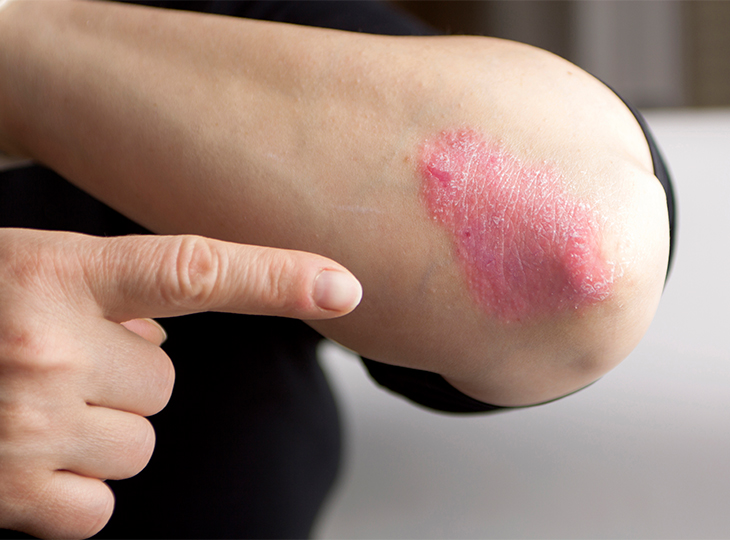Tues: 8:30am - 3:00pm
Wed: 12:00pm - 6:00pm
Thurs: 8:30am - 3:00pm
Fri: Closed
Sat: 8:30am - 12:30pm
Sun: Closed
Greenvale, NY 11548
August is Psoriasis Action Month


This August marks the 25th anniversary of Psoriasis Action Month, an effort to educate people about the causes and triggers of this skin disease, as well as effective methods of treatment.
Psoriasis is neither deadly nor dangerous, but it can be uncomfortable and embarrassing. Although the definitive cause of psoriasis is not known, dermatologists suspect the condition may be triggered by problems with the body’s immune system. Genetics may also play a role.
The condition appears as scaly, red, and raised patches on the skin, typically on the elbows, knees, and scalp, although it can affect other areas. Itching, burning, and stinging in the affected areas are common complaints.
Psoriasis develops when the body replaces skin cells faster than normal. These cells develop in the deepest layer of your skin, rising gradually until they reach the outermost level where they die and flake off to make way for new skin cells. This process normally takes 3 to 4 weeks, according to the National Psoriasis Foundation, however, with psoriasis it occurs four times as fast – in 3 to 7 days. As a result, immature cells build up rapidly on the skin’s surface, causing flaky, crusty red patches covered with scales. This can trigger itching, which my lead to skin damage as well as bleeding and scarring. The affected area is also highly visible and may cause people who suffer from psoriasis to hide the condition by covering their skin. This often worsens the itching.
National Psoriasis Action Month began in 1997 as an initiative of the National Psoriasis Foundation. Though it began in October, the observance was moved to August partly because common summer outdoor activities like sunbathing and swimming expose the skin.
Sun exposure has been shown to have a positive effect on psoriasis. However, in order to help clear psoriasis, sun exposure needs to be spread over time, according to The Psoriasis and Psoriatic Arthritis Alliance. A week at the beach may help, but it typically won’t clear psoriasis completely. You also want to avoid overexposure, which can result in sunburn and only make psoriasis more painful. How long you can stay in the sun depends on several factors, though especially the daily UV Index. An index of 6-7 is considered “high” and anything above 7 is “very high.” When the UV Index is at least 6, as it often is in August, unprotected skin can burn in as little as 10 minutes, so use sunblock. A lotion rated at SPF30 will protect from nearly 97% of the sun’s UV rays. SPF50 affords about 98% protection; anything higher than 50 will provide negligible extra protection since no sunblock is 100% effective.
Psoriasis Action Month also aims to reduce the stigma of the disease, which can affect anyone at any age, while offering educational resources and dispelling misinformation. Eliminating the stigma of psoriasis is especially important for children who develop the condition, as their appearance may ostracize them from their peer groups.
Perhaps the most important psoriasis myth to dispel is whether you can catch it from other people. The answer is no. Psoriasis is not contagious. Another myth associated with psoriasis is that it’s the result of poor hygiene. Not true. Psoriasis is believed to be an autoimmune disorder. You can shower 10 times a day and still develop psoriasis. The disease has nothing to do with cleanliness.
The impact of psoriasis varies among people. In severe cases, 10% or more of the skin may be affected by the disease. In moderate cases, 3% to 10% of the skin may develop psoriasis. In mild cases, less than 3%. About 30% of patients with psoriasis will also develop arthritis. Patients who experience joint pain accompanied by psoriasis should seek immediate care so the joint condition does not worsen.
Your dermatologist will diagnose and assess the extent of your psoriasis by reviewing your medical history (including any history of joint pain). This includes a thorough physical exam that consists of examining your skin, scalp and nails. It may also be necessary to take a small skin sample (biopsy), to diagnose the condition.
While there is no permanent cure for psoriasis and it can recur in cycles, the condition is highly treatable. Psoriasis triggers include stress, trauma, skin injuries and infections, vitamin D deficiency, excessive alcohol consumption, smoking and some medications.
Prescription-strength creams and ointments applied topically can clear skin patches in mild-to-moderate cases. In more severe cases, you’ll want to consult with a dermatologist about light therapy, including U.V.B. phototherapy, and psoralen plus ultraviolet A (PUVA). For extreme psoriasis, patients may be prescribed retinoids, methotrexate, and cyclosporine, an immunosuppressive drug.
One of the main goals of Psoriasis Action Month is to reassure people that there’s no need to be ashamed or suffer needlessly. Help is readily available. Learn more about psoriasis treatment.
Let Walk-in Dermatology Take Care of You
If you have concerns about psoriasis or any other any skin condition and need dependable answers fast, you don’t have to wonder, worry or wait. Walk-in Dermatology is here to keep you healthy. Our team of dermatologists and experienced healthcare staff will address your concerns and provide the necessary care for all your skin conditions. We can set up a Video Visit and even prescribe medications remotely, or you can schedule an appointment with us online. The choice is yours. But don’t wait until the problem gets worse. Contact us today.








